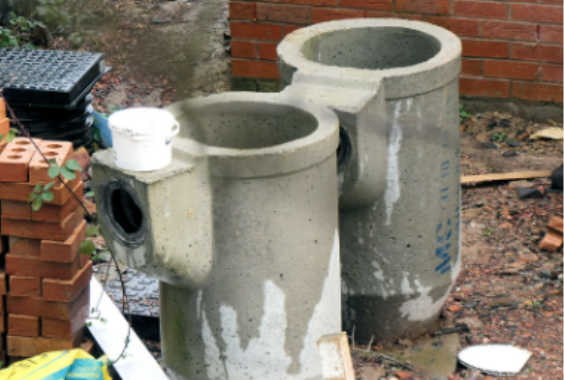Road Gullies Ireland
Comprehensive Water Management Solutions with Road Gullies Ireland
Road gullies are a specific type of drainage gully designed to be installed along roadways to collect rainwater and surface runoff from the road surface. They are an essential component of urban drainage systems, helping to prevent water accumulation and potential damage to the road structure. Road gullies are strategically placed along the curbs or edges of roads to capture water before it can cause pooling or erosion. They are connected to underground drainage pipes that carry the collected water to larger stormwater management systems or natural water bodies
Revolutionary Concrete Road Gullies Ireland
Experience enhanced functionality with our round trapped gullies, which employ a water seal to eliminate odors. Alternatively, use untrapped square gullies and silt boxes to efficiently collect surface water. Silt Boxes arrive with one pre-tapped hole, with the option to tap out the remaining three as needed.
Elevating Your Water Management
Choose from our comprehensive range of Concrete Channels and Road Gullies to optimize your site’s wastewater management. From efficient drainage to odor elimination, our solutions are tailored to meet your diverse needs.
The road gullies are larger, but they work the same. The outlets are 150mm in diameter, not 100mm. They come in different sizes and depths. Road gullies are used in carriageways to drain a maximum of 250m2.
Road gullies were usually large clayware items until about 30 years ago. However, their fragility was a constant problem. Pre-cast concrete units were gradually introduced, which are more durable but also heavier. Excavators are required to crane the larger 450mm units into place. They weigh too much for a single worker to lift. If the gully wasn’t positioned and leveled correctly the first time around, it was difficult to make adjustments. This involved craning out the unit, making the necessary adjustments to the bed concrete, and then craning back the unit into place.
In recent years, heavy, cumbersome clayware and PCC units have been replaced with lightweight plastic units that do not provide the strength or resistance to deformation usually provided by these units. Instead, they act as a lining mold for in situ concrete casting. After the pipework has been completed and the unit is in place, the concrete surround is poured and vibrated/compacted for the required strength to resist deformation. A single person can install and handle these units with relative ease. This saves both time and money.
Lightweight plastic gully liner. It is important to note that each gully requires a grating which is usually placed on top of regulating masonry or cover slabs. All road gullies must be surrounded and bedded with mass concrete, including the pre-cast concrete ones.
Concrete road gully under construction Some local authorities insist that the regulating wall be built directly on top of the concrete gully/surround.
The grating must be installed before the final surfacing/paving.
To accommodate smaller gratings on the larger pots with a diameter of 450mm, it is common for the brickwork to be corbelled inwards. The corbelled course should not exceed the preceding course in height by more than 50mm.
Your Queries, Our Expertise
Got questions about, road gullies, drainage gullies, asphalt, or tarmacadam? Our team of experts is at your service. Reach out with your queries, and rest assured, we have the perfect solution waiting for you.
A Spectrum of Services
Mactar’s commitment goes beyond drainage gullies. Explore our wide array of services, encompassing Civil Engineering, Road Construction, Routine Maintenance, and even Hot Box Hire.
FAQ
What is the primary purpose of road gullies in the context of urban drainage systems?
Road gullies serve as crucial components of urban drainage systems, specifically designed to collect rainwater and surface runoff from road surfaces. Their strategic placement along curbs or road edges helps prevent water accumulation, protecting the road structure from potential damage caused by pooling or erosion.
What distinguishes the newer lightweight plastic gully liners from traditional clayware and pre-cast concrete units?
Lightweight plastic gully liners, a recent innovation, replace heavy clayware and pre-cast concrete units. These liners serve as molds for in situ concrete casting, allowing for easier installation by a single person. Unlike their predecessors, they offer time and cost savings during installation while providing sufficient strength to resist deformation.
What are the key considerations for the construction and installation of road gullies, including grating placement and final surfacing?
Road gullies, irrespective of type, require careful construction and installation. Gratings must be installed on regulating masonry or cover slabs, surrounded and bedded with mass concrete. Some local authorities may require the regulating wall directly on top of the gully. The grating installation precedes final surfacing, and for larger pots, brickwork may be corbelled inwards to accommodate smaller gratings.
What makes Concrete Road Gullies in Ireland revolutionary, and how do they enhance functionality?
Concrete Road Gullies in Ireland offer enhanced functionality with features such as round trapped gullies employing a water seal to eliminate odors. Additionally, untrapped square gullies and silt boxes efficiently collect surface water. The range includes options like pre-tapped holes in silt boxes, providing flexibility in installation.
How does the construction process of road gullies differ between traditional and modern approaches?
Traditional road gullies involved large, heavy clayware or pre-cast concrete units, requiring cranes for installation and adjustments. In contrast, modern lightweight plastic gully liners facilitate a more straightforward installation process. The concrete surround is poured after pipework, and the unit is in place, saving both time and money.

